Blog
Identifying Hammertoe and Its Causes
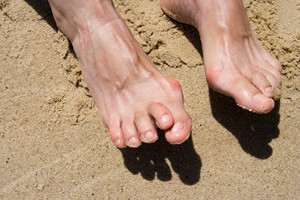
Hammertoe is a foot deformity where one or more of the smaller toes bend abnormally at the middle joint, resembling a hammer. This condition often results from an imbalance in the muscles, tendons, or ligaments that normally keep the toe straight. Common causes can include wearing ill-fitting shoes, especially those that are too tight or have high heels, which force the toe into a bent position. Other contributing factors include genetic predisposition, arthritis, and trauma to the toe. Symptoms of hammertoe include pain or irritation on the affected toe, especially when wearing shoes, as well as corns or calluses forming on the top of the joint due to friction. The affected toe may also become red, swollen, or stiff. Early detection is essential for effective treatment, which may involve changing footwear, using orthotic devices, and performing toe exercises. If you have developed a hammertoe, it is suggested that you consult a podiatrist who can offer you effective treatment options, which may include surgery for severe cases that can relieve pain and correct the deformity.
Hammertoe
Hammertoes can be a painful condition to live with. For more information, contact Richard P. Jacoby, DPM from Extremity Health Centers. Our doctor will answer any of your foot- and ankle-related questions.
Hammertoe is a foot deformity that affects the joints of the second, third, fourth, or fifth toes of your feet. It is a painful foot condition in which these toes curl and arch up, which can often lead to pain when wearing footwear.
Symptoms
- Pain in the affected toes
- Development of corns or calluses due to friction
- Inflammation
- Redness
- Contracture of the toes
Causes
Genetics – People who are genetically predisposed to hammertoe are often more susceptible
Arthritis – Because arthritis affects the joints in your toes, further deformities stemming from arthritis can occur
Trauma – Direct trauma to the toes could potentially lead to hammertoe
Ill-fitting shoes – Undue pressure on the front of the toes from ill-fitting shoes can potentially lead to the development of hammertoe
Treatment
Orthotics – Custom made inserts can be used to help relieve pressure placed on the toes and therefore relieve some of the pain associated with it
Medications – Oral medications such as anti-inflammatories or NSAIDs could be used to treat the pain and inflammation hammertoes causes. Injections of corticosteroids are also sometimes used
Surgery – In more severe cases where the hammertoes have become more rigid, foot surgery is a potential option
If you have any questions please contact one of our offices located in Scottsdale and Buckeye, AZ . We offer the newest diagnostic and treatment technologies for all your foot and ankle needs.
Are You Suffering From Ingrown Toenails?
Effective Exercises to Enhance Foot Strength for Ballet Dancers
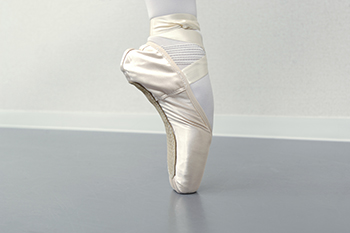
For ballet dancers, strong and flexible feet are essential for mastering intricate movements with precision and grace. Various foot stretches and exercises can help strengthen the muscles and improve the articulation of the feet. Using a hair elastic around the toes to create resistance while pointing and flexing helps develop intrinsic foot muscles. Thera bands provide resistance for exercises such as ankle dorsiflexion and plantarflexion, enhancing ankle stability and strength. Towel scrunches, where dancers use their toes to gather a hand towel, target the muscles of the feet and toes. Practicing tennis ball massages can alleviate tension and promote flexibility in the arches. Exercises like doming, toe teasers, and piano toes engage different foot muscles, enhancing overall strength and control. If you have injured your foot due to ballet moves, it is suggested that you visit a podiatrist who can offer appropriate treatment and guide you toward additional stretching techniques.
Stretching the feet is a great way to prevent injuries. If you have any concerns with your feet consult with Richard P. Jacoby, DPM from Extremity Health Centers. Our doctor will assess your condition and provide you with quality foot and ankle treatment.
Stretching the Feet
Being the backbone of the body, the feet carry your entire weight and can easily become overexerted, causing cramps and pain. As with any body part, stretching your feet can serve many benefits. From increasing flexibility to even providing some pain relief, be sure to give your feet a stretch from time to time. This is especially important for athletes or anyone performing aerobic exercises, but anyone experiencing foot pain or is on their feet constantly should also engage in this practice.
Great ways to stretch your feet:
- Crossing one leg over the others and carefully pull your toes back. Do 10-20 repetitions and repeat the process for each foot
- Face a wall with your arms out and hands flat against the wall. Step back with one foot and keep it flat on the floor while moving the other leg forward. Lean towards the wall until you feel a stretch. Hold for 30 seconds and perform 10 repetitions for each foot
- Be sure not to overextend or push your limbs too hard or you could risk pulling or straining your muscle
Individuals who tend to their feet by regular stretching every day should be able to minimize foot pain and prevent new problems from arising.
If you have any questions, please feel free to contact one of our offices located in Scottsdale and Buckeye, AZ . We offer the newest diagnostic and treatment technologies for all your foot care needs.
Idiopathic Toe Walking in Children
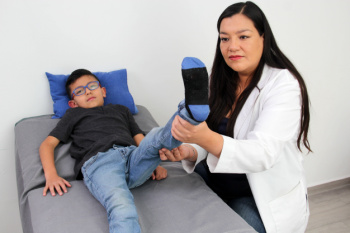
Idiopathic toe walking is a phenomenon where children habitually walk on their toes without any underlying medical condition or known cause. While toe walking is common in toddlers who are learning to walk, persistent toe walking beyond the age of three without any identifiable cause can be a cause for concern. Children with idiopathic toe walking typically walk on their toes with their heels off the ground during most or all of their walking activities. This behavior can affect their balance, coordination, and overall motor development. While the exact cause of idiopathic toe walking remains unclear, it is believed to involve a combination of factors including tightness in the calf muscles, sensory processing issues, or developmental delays. Early intervention is vital in addressing idiopathic toe walking and preventing potential complications such as muscle stiffness or contractions. Treatment may involve specific stretches that can strengthen the calf muscles, orthotic devices to encourage heel contact, and monitoring to track developmental progress and address any underlying issues. If your child has this condition, it is strongly suggested that you seek the advice of a podiatrist who can guide you toward appropriate treatment measures.
Making sure that your children maintain good foot health is very important as they grow. If you have any questions, contact Richard P. Jacoby, DPM of Extremity Health Centers. Our doctor can provide the care you need to keep you pain-free and on your feet.
Keeping Children's Feet Healthy
Having healthy feet during childhood can help prevent medical problems later in life, namely in the back and legs. As children grow, their feet require different types of care. Here are some things to consider...
Although babies do not walk yet, it is still very important to take care of their feet.
Avoid putting tight shoes or socks on his or her feet.
Allow the baby to stretch and kick his or her feet to feel comfortable.
As a toddler, kids are now on the move and begin to develop differently. At this age, toddlers are getting a feel for walking, so don’t be alarmed if your toddler is unsteady or ‘walks funny’.
As your child gets older, it is important to teach them how to take care of their feet.
Show them proper hygiene to prevent infections such as fungus.
Be watchful for any pain or injury.
Have all injuries checked by a doctor as soon as possible.
Comfortable, protective shoes should always be worn, especially at play.
If you have any questions please feel free to contact one of our offices located in Scottsdale and Buckeye, AZ . We offer the newest diagnostic and treatment technologies for all your foot and ankle needs.
Rheumatoid Arthritis and Foot Swelling
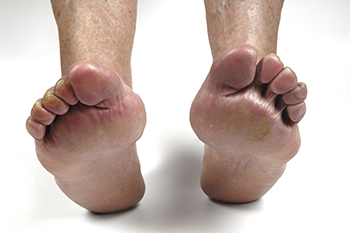 Rheumatoid arthritis, or RA, is an autoimmune disease that primarily affects joints, frequently targeting the feet and ankles. Common symptoms include swelling, pain, and inflammation in the affected joints. In RA, the immune system mistakenly attacks the joint lining, leading to chronic inflammation that can damage the joints and surrounding tissues over time. As a result, the foot and ankle joints often become swollen and painful, which can make walking and standing uncomfortable or even debilitating. The swelling is often symmetrical, meaning it typically affects the same joints on both sides of the body simultaneously. Treatment may include medication to reduce inflammation and slow disease progression. Targeted stretching to maintain joint function and orthotics to support the joints and alleviate pressure are other possible measures. Regular visits to a podiatrist, or foot doctor, are important for those with RA to monitor their foot health. If you suffer from rheumatoid arthritis and the associated swelling in the feet and ankles, it is suggested you make an appointment with a podiatrist today.
Rheumatoid arthritis, or RA, is an autoimmune disease that primarily affects joints, frequently targeting the feet and ankles. Common symptoms include swelling, pain, and inflammation in the affected joints. In RA, the immune system mistakenly attacks the joint lining, leading to chronic inflammation that can damage the joints and surrounding tissues over time. As a result, the foot and ankle joints often become swollen and painful, which can make walking and standing uncomfortable or even debilitating. The swelling is often symmetrical, meaning it typically affects the same joints on both sides of the body simultaneously. Treatment may include medication to reduce inflammation and slow disease progression. Targeted stretching to maintain joint function and orthotics to support the joints and alleviate pressure are other possible measures. Regular visits to a podiatrist, or foot doctor, are important for those with RA to monitor their foot health. If you suffer from rheumatoid arthritis and the associated swelling in the feet and ankles, it is suggested you make an appointment with a podiatrist today.
Because RA affects more than just your joints, including the joints in your feet and ankles, it is important to seek early diagnosis from your podiatrist if you feel like the pain in your feet might be caused by RA. For more information, contact Richard P. Jacoby, DPM of Extremity Health Centers. Our doctor will assist you with all of your podiatric concerns.
What Is Rheumatoid Arthritis?
Rheumatoid Arthritis (RA) is an autoimmune disorder in which the body’s own immune system attacks the membranes surrounding the joints. Inflammation of the lining and eventually the destruction of the joint’s cartilage and bone occur, causing severe pain and immobility.
Rheumatoid Arthritis of the Feet
Although RA usually attacks multiple bones and joints throughout the entire body, almost 90 percent of cases result in pain in the foot or ankle area.
Symptoms
- Swelling and pain in the feet
- Stiffness in the feet
- Pain on the ball or sole of feet
- Joint shift and deformation
Diagnosis
Quick diagnosis of RA in the feet is important so that the podiatrist can treat the area effectively. Your doctor will ask you about your medical history, occupation, and lifestyle to determine the origin of the condition. Rheumatoid Factor tests help to determine if someone is affected by the disease.
If you have any questions please feel free to contact one of our offices located in Scottsdale and Buckeye, AZ . We offer the newest diagnostic and treatment technologies for all your foot and ankle needs.
Foot Pain Caused by Cycling

Foot pain while cycling can quickly turn a joyful bike ride into a struggle. Whether it's blisters, hot spots, or the burning discomfort of hot-foot, understanding the root causes of foot pain during a ride is essential for finding relief. Blisters often arise from the repetitive rubbing and pressure points caused by wearing ill-fitting shoes. Meanwhile, hot-foot, which is a fiery sensation in the ball of the foot, typically occurs during long or hot rides due to nerve compression from foot swelling. To address these issues, wearing stiff-soled cycling shoes can improve power transfer and reduce pressure. A proper shoe fit is also important to ensure a snug yet comfortable feel, especially as feet tend to swell during rides. Optimizing your bike setup by adjusting cleat positions and experimenting with different pedal platforms may further alleviate pressure points. Maintaining good foot hygiene, selecting appropriate socks, and choosing pedal platforms suited to your riding style can all contribute to a less painful cycling experience. However, if foot pain persists after a long bike ride, it is suggested that you schedule an appointment with a podiatrist for an exam and diagnosis.
Ankle and foot injuries are common among athletes and in many sports. They can be caused by several problems and may be potentially serious. If you are feeling pain or think you were injured in a sporting event or when exercising, consult with Richard P. Jacoby, DPM from Extremity Health Centers. Our doctor will assess your condition and provide you with quality foot and ankle treatment.
Common Injuries
The most common injuries that occur in sporting activities include:
- Achilles Tendonitis
- Achilles Tendon Rupture
- Ankle Sprains
- Broken Foot
- Plantar Fasciitis
- Stress Fractures
- Turf Toe
Symptoms
Symptoms vary depending upon the injury and in some cases, there may be no symptoms at all. However, in most cases, some form of symptom is experienced. Pain, aching, burning, bruising, tenderness, tightness or stiffness, sensation loss, difficulty moving, and swelling are the most common symptoms.
Treatment
Just as symptoms vary depending upon the injury, so do treatment options. A common treatment method is known as the RICE method. This method involves rest, applying ice, compression and elevating the afflicted foot or ankle. If the injury appears to be more serious, surgery might be required, such as arthroscopic or reconstructive surgery. Lastly, rehabilitation or therapy might be needed to gain full functionality in the afflicted area. Any discomfort experienced by an athlete must be evaluated by a licensed, reputable medical professional.
If you have any questions, please feel free to contact one of our offices located in Scottsdale and Buckeye, AZ . We offer the newest diagnostic and treatment technologies for all your foot care needs.
Are You Suffering From Nerve Damage?
How Podiatrists Help With Diabetic Foot Care
 Podiatrists play a key role when it comes to managing and preventing foot-related complications in diabetes patients. Foot issues are a common occurrence in diabetics, due to the poor blood circulation and nerve damage, or neuropathy, that often accompany the disease. Podiatrists specialize in early detection and treatment of potential foot problems like ulcers, infections, and structural issues. This makes regular check-ups with podiatrists important for someone who is at risk for these issues. During visits, a podiatrist will conduct comprehensive foot exams to look for signs of decreased circulation, changes in foot structure, or nerve damage. This foot doctor can provide guidance on proper foot care practices, such as how to safely trim nails and avoid injuries. Podiatrists may also recommend appropriate footwear to prevent pressure sores and injuries. Additionally, podiatrists can treat any current foot problems to prevent them from escalating into more serious conditions that could lead to amputation. By closely monitoring the health of a diabetic's feet, podiatrists help maintain mobility and prevent life-threatening complications. If you are at risk for foot complications due to diabetes, it is suggested that you add a podiatrist to your regular care team.
Podiatrists play a key role when it comes to managing and preventing foot-related complications in diabetes patients. Foot issues are a common occurrence in diabetics, due to the poor blood circulation and nerve damage, or neuropathy, that often accompany the disease. Podiatrists specialize in early detection and treatment of potential foot problems like ulcers, infections, and structural issues. This makes regular check-ups with podiatrists important for someone who is at risk for these issues. During visits, a podiatrist will conduct comprehensive foot exams to look for signs of decreased circulation, changes in foot structure, or nerve damage. This foot doctor can provide guidance on proper foot care practices, such as how to safely trim nails and avoid injuries. Podiatrists may also recommend appropriate footwear to prevent pressure sores and injuries. Additionally, podiatrists can treat any current foot problems to prevent them from escalating into more serious conditions that could lead to amputation. By closely monitoring the health of a diabetic's feet, podiatrists help maintain mobility and prevent life-threatening complications. If you are at risk for foot complications due to diabetes, it is suggested that you add a podiatrist to your regular care team.
Diabetic foot care is important in preventing foot ailments such as ulcers. If you are suffering from diabetes or have any other concerns about your feet, contact Richard P. Jacoby, DPM from Extremity Health Centers. Our doctor can provide the care you need to keep you pain-free and on your feet.
Diabetic Foot Care
Diabetes affects millions of people every year. The condition can damage blood vessels in many parts of the body, especially the feet. Because of this, taking care of your feet is essential if you have diabetes, and having a podiatrist help monitor your foot health is highly recommended.
The Importance of Caring for Your Feet
- Routinely inspect your feet for bruises or sores.
- Wear socks that fit your feet comfortably.
- Wear comfortable shoes that provide adequate support.
Patients with diabetes should have their doctor monitor their blood levels, as blood sugar levels play such a huge role in diabetic care. Monitoring these levels on a regular basis is highly advised.
It is always best to inform your healthcare professional of any concerns you may have regarding your feet, especially for diabetic patients. Early treatment and routine foot examinations are keys to maintaining proper health, especially because severe complications can arise if proper treatment is not applied.
If you have any questions please feel free to contact one of our offices located in Scottsdale and Buckeye, AZ . We offer the newest diagnostic and treatment technologies for all your foot and ankle needs.
Causes and Definition of Foot Ulcers
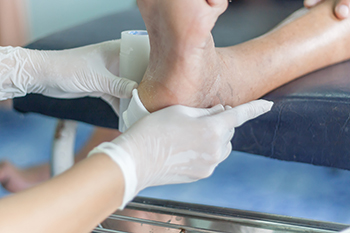
Foot ulcers are open wounds that develop on the feet, often affecting individuals with diabetes or impaired circulation. They typically occur due to a combination of factors, including neuropathy, which is nerve damage, poor blood flow, and pressure from footwear. Foot ulcers can vary in severity, from shallow sores to deep craters, and if left untreated, they can lead to serious complications such as infection and possibly amputation. The primary cause of foot ulcers is prolonged pressure or friction on the skin, which can result from wearing ill-fitting shoes, walking barefoot, or excessive rubbing. In diabetic individuals, high blood sugar levels can further exacerbate the risk by damaging nerves and blood vessels, impairing the body's ability to heal. Other contributing factors may include poor hygiene, smoking, obesity, and a history of foot problems. Recognizing the signs of a foot ulcer, such as redness, swelling, or drainage, is vital for prompt treatment and prevention of complications. If you have a foot wound, it is strongly suggested that you consult a podiatrist who can diagnose its severity, and offer treatment options that are right for you.
Wound care is an important part in dealing with diabetes. If you have diabetes and a foot wound or would like more information about wound care for diabetics, consult with Richard P. Jacoby, DPM from Extremity Health Centers. Our doctor will assess your condition and provide you with quality foot and ankle treatment.
What Is Wound Care?
Wound care is the practice of taking proper care of a wound. This can range from the smallest to the largest of wounds. While everyone can benefit from proper wound care, it is much more important for diabetics. Diabetics often suffer from poor blood circulation which causes wounds to heal much slower than they would in a non-diabetic.
What Is the Importance of Wound Care?
While it may not seem apparent with small ulcers on the foot, for diabetics, any size ulcer can become infected. Diabetics often also suffer from neuropathy, or nerve loss. This means they might not even feel when they have an ulcer on their foot. If the wound becomes severely infected, amputation may be necessary. Therefore, it is of the upmost importance to properly care for any and all foot wounds.
How to Care for Wounds
The best way to care for foot wounds is to prevent them. For diabetics, this means daily inspections of the feet for any signs of abnormalities or ulcers. It is also recommended to see a podiatrist several times a year for a foot inspection. If you do have an ulcer, run the wound under water to clear dirt from the wound; then apply antibiotic ointment to the wound and cover with a bandage. Bandages should be changed daily and keeping pressure off the wound is smart. It is advised to see a podiatrist, who can keep an eye on it.
If you have any questions, please feel free to contact one of our offices located in Scottsdale and Buckeye, AZ . We offer the newest diagnostic and treatment technologies for all your foot care needs.
Dealing with Blisters Between the Toes

Blisters between the toes can be a real pain, whether they're caused by friction, insect bites, burns, or infections. These little pockets of fluid can make each step a challenge. Friction is often the main cause of blisters between the toes. When your toes rub against each other or your shoes, the skin becomes irritated and leads to blister formation. Other causes of blisters between the toes include insect bites, burns, and various infections. While most blisters will heal on their own within a week or two, it's essential to resist the urge to pop them. Breaking a blister can increase the risk of infection and prolong the healing process. Instead, keep the blister clean and covered with a bandage. If the blister is particularly painful or shows signs of infection, it's best to seek medical attention from a podiatrist. Preventing blisters between the toes starts with wearing properly fitting shoes and socks. Avoid walking long distances in new shoes, and be sure to change socks if they become damp. If you have persistent or severe blisters between the toes, it is suggested that you seek help from a podiatrist for relief.
Blisters are prone to making everyday activities extremely uncomfortable. If your feet are hurting, contact Richard P. Jacoby, DPM of Extremity Health Centers. Our doctor can provide the care you need to keep you pain-free and on your feet.
Foot Blisters
Foot blisters develop as a result of constantly wearing tight or ill-fitting footwear. This happens due to the constant rubbing from the shoe, which can often lead to pain.
What Are Foot Blisters?
A foot blister is a small fluid-filled pocket that forms on the upper-most layer of the skin. Blisters are filled with clear fluid and can lead to blood drainage or pus if the area becomes infected.
How Do Blisters Form?
Blisters on the feet are often the result of constant friction of skin and material, usually by shoe rubbing. Walking in sandals, boots, or shoes that don’t fit properly for long periods of time can result in a blister. Having consistent foot moisture and humidity can easily lead to blister formation.
Prevention & Treatment
It is important to properly care for the affected area in order to prevent infection and ease the pain. Do not lance the blister and use a Band-Aid to provide pain relief. Also, be sure to keep your feet dry and wear proper fitting shoes. If you see blood or pus in a blister, seek assistance from a podiatrist.
If you have any questions, please feel free to contact one of our offices located in Scottsdale and Buckeye, AZ . We offer the newest diagnostic and treatment technologies for all your foot care needs.
More...
Causes and Symptoms of Achilles Tendonitis
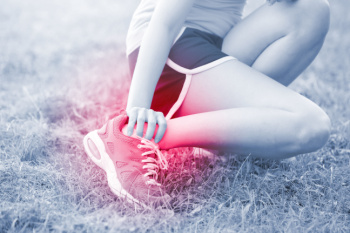
Despite its association with strength, the Achilles tendon is susceptible to injury which can lead to discomfort and impair mobility. Several factors contribute to the development of Achilles tendonitis, including wearing improper footwear, overexertion during activities like speed or mountain running, and insufficient recovery time between training sessions. Other causes can include incorrect loading of weight on the legs or feet, poor running technique, and a lack of proper warm-up exercises. These factors collectively strain this strong tendon, leading to micro-tears in its structure. If left untreated, Achilles tendonitis can progress through various stages of severity. Initially, Achilles tendonitis may cause discomfort during activity or mild pain, which diminishes with rest and conservative measures. However, as the condition progresses, symptoms worsen, with visible changes in the tendon's structure and increased pain levels. Scar tissue formation and a loss of full functionality characterize the advanced stage of this injury. If you are experiencing Achilles tendon pain, it is suggested that you schedule an appointment with a podiatrist for an exam, diagnosis, and treatment options.
Achilles tendon injuries need immediate attention to avoid future complications. If you have any concerns, contact Richard P. Jacoby, DPM of Extremity Health Centers. Our doctor can provide the care you need to keep you pain-free and on your feet.
What Is the Achilles Tendon?
The Achilles tendon is a tendon that connects the lower leg muscles and calf to the heel of the foot. It is the strongest tendon in the human body and is essential for making movement possible. Because this tendon is such an integral part of the body, any injuries to it can create immense difficulties and should immediately be presented to a doctor.
What Are the Symptoms of an Achilles Tendon Injury?
There are various types of injuries that can affect the Achilles tendon. The two most common injuries are Achilles tendinitis and ruptures of the tendon.
Achilles Tendinitis Symptoms
- Inflammation
- Dull to severe pain
- Increased blood flow to the tendon
- Thickening of the tendon
Rupture Symptoms
- Extreme pain and swelling in the foot
- Total immobility
Treatment and Prevention
Achilles tendon injuries are diagnosed by a thorough physical evaluation, which can include an MRI. Treatment involves rest, physical therapy, and in some cases, surgery. However, various preventative measures can be taken to avoid these injuries, such as:
- Thorough stretching of the tendon before and after exercise
- Strengthening exercises like calf raises, squats, leg curls, leg extensions, leg raises, lunges, and leg presses
If you have any questions please feel free to contact one of our offices located in Scottsdale and Buckeye, AZ . We offer the newest diagnostic tools and technology to treat your foot and ankle needs.
Heel Pain in the Morning?
Symptoms of a Broken Foot
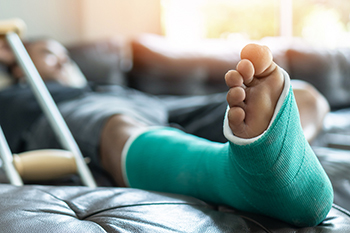
A broken foot often results from a sudden or traumatic injury and requires early recognition for appropriate treatment. While symptoms may overlap with less severe injuries like sprains, specific signs of a broken foot indicate a more serious issue needing immediate medical attention. Sensations of bones out of place or grinding within the foot may signal a break, warranting minimal movement to prevent further damage. Swelling, often accompanied by extreme pain, is common with a broken foot, persisting longer and more pronounced than a sprain. Bruising near the fracture site, spreading over time, indicates a broken foot, and requires evaluation from a podiatrist if persistent or worsening. Difficulty bearing weight on the foot, in addition to restricted movement and intense pain, suggests a broken bone. Immediate medical attention aids in accurate diagnosis and treatment planning. Seeking prompt evaluation from a podiatrist is imperative, and X-rays are essential for confirmation. Treatment typically involves immobilization with a splint or cast to support proper healing. If you suspect a broken bone in your foot, it is suggested that you make an emergency appointment with a podiatrist for an exam and diagnosis.
A broken foot requires immediate medical attention and treatment. If you need your feet checked, contact Richard P. Jacoby, DPM from Extremity Health Centers. Our doctor can provide the care you need to keep you pain-free and on your feet.
Broken Foot Causes, Symptoms, and Treatment
A broken foot is caused by one of the bones in the foot typically breaking when bended, crushed, or stretched beyond its natural capabilities. Usually the location of the fracture indicates how the break occurred, whether it was through an object, fall, or any other type of injury.
Common Symptoms of Broken Feet:
- Bruising
- Pain
- Redness
- Swelling
- Blue in color
- Numbness
- Cold
- Misshapen
- Cuts
- Deformities
Those that suspect they have a broken foot shoot seek urgent medical attention where a medical professional could diagnose the severity.
Treatment for broken bones varies depending on the cause, severity and location. Some will require the use of splints, casts or crutches while others could even involve surgery to repair the broken bones. Personal care includes the use of ice and keeping the foot stabilized and elevated.
If you have any questions please feel free to contact one of our offices located in Scottsdale and Buckeye, AZ . We offer the newest diagnostic and treatment technologies for all your foot and ankle needs.
Causes of Foot Pain in Children
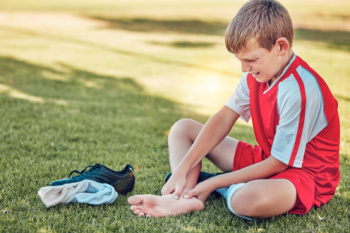
Understanding the causes of foot pain in children is essential for parents. Common factors that may affect your child’s feet include wearing ill-fitting shoes without proper cushioning, which can lead to pain over time. Conditions like Achilles tendonitis, often observed in active children, result from repetitive strain on the Achilles tendon and can lead to swelling and pain. Fractures and injuries can cause acute pain and contribute to the development of bunions. Bursitis and corns or calluses, often caused by wearing poorly fitting shoes, can result in inflammation and thickened skin. Structural issues, such as flat feet, or postural defects may also contribute to childhood foot discomfort. Inflammatory conditions like juvenile arthritis can cause persistent foot pain. For appropriate treatment to address your child's foot pain, it is suggested that you schedule an appointment with a podiatrist who can conduct a full exam and offer an accurate diagnosis and effective treatment plan.
The health of a child’s feet is vital to their overall well-being. If you have any questions regarding foot health, contact Richard P. Jacoby, DPM of Extremity Health Centers. Our doctor can provide the care you need to keep you pain-free and on your feet.
Tips for Keeping Children's Feet Healthy
- Make sure their shoes fit properly
- Look for any signs of in-toeing or out-toeing
- Check to see if they have Clubfoot (condition that affects your child’s foot and ankle, twisting the heel and toes inward) which is one of the most common nonmajor birth defects.
- Lightly cover your baby’s feet (Tight covers may keep your baby from moving their feet freely, and could prevent normal development)
- Allow your toddler to go shoeless (Shoes can be restricting for a young child’s foot)
- Cut toenails straight across to avoid ingrown toenails
- Keep your child’s foot clean and dry
- Cover cuts and scrapes. Wash any scratches with soap and water and cover them with a bandage until they’ve healed.
If you have any questions, please feel free to contact one of our offices located in Scottsdale and Buckeye, AZ . We offer the newest diagnostic and treatment technologies for all your foot care needs.



